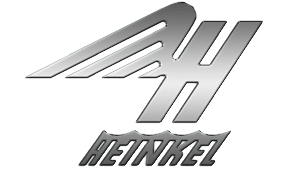


History and Specifications
Around 170,000 scooters were produced by Heinkel between 1953 and 1964. All scooters were built at the factory in Karlsruhe, Germany, which was specifically designed for this purpose. The engines were supplied by the factory in Speyer (see below).
These scooters made were well received by the motorcycle press in the road tests and were commercially successful in many European countries. The "Tourist" model was for many years the sales leader in Germany, despite their relatively high price.
Heinkel scooters also managed to achieve good results in sports events and endurance trials in the late 1950s and early 1960s, achieving a reputation of the "Rolls Royce of Scooters."
During those years they were awarded:
70 Gold Medals
27 Silver Medals
14 Bronze Medals
17 Victories in Class
13 Gold Medals in Teams
3 Silver Medals in Teams
3 Bronze Medals in Teams
A 1964 brochure announced that 5,000 million km had already been traveled by Heinkel scooters, an average of 40,000 km per machine.
Many covered over 160,000 km with only standard revisions and normal maintenance.
Most of the Heinkel scooters were Tourist models. Attempts to produce a lighter machine were less successful.
Here are the approximate numbers of machines produced:
Heinkel Type 112 125cc 1957 125cc 5
Heinkel Type 150 150cc 1962-64 150cc 7,000
Tourist 101A0
149 cc 7.2 PS
1953 to 1954
The first prototype of the brand was built in 1949 but was not announced until January 1953, shortly before the Motorcycle Show in Brussels, starting production in April of that year at the Karlsruhe factory, with the first deliveries at the end of the year. The design of these scooters was strongly influenced by the company's aviation experts. A tubular steel frame was complemented by pressed-metal bodywork. The front suspension consisted of telescopic arms and swinging arm rear suspension with hydraulic damper. It had a single-cylinder 149cc OHV engine, (59mm x 54.5mm) delivering 7.2 bhp at 5,200 rpm. The gearbox was three-speed operated from the handlebar. The transmission was effected by an oil bath. The maximum speed claimed was 90 km and its aerodynamic design allowed a fuel consumption of only 2.5 l / 100 km. The Tourist was designed as a luxury machine.
Its equipment was complete with steering lock, speedometer, clock, spare tire and luggage compartment. The early versions were fitted with a 6 volt electrical system, but in June 1954 with the addition of a starter this was upgraded to 12 volts. In August of 1954 this model was replaced by 102A1.
Tourist 102A1
174 cc / 9.2 PS
1954 to 1955
The main change from the old model was the increase of the displacement to 175cc (60mm x 61.5mm), with the power reaching 9.2 bhp at 5,200 rpm. Although this did little to change the maximum speed, because the gearbox was the same, the increase of power made the transport of the passenger and load easier. The carburetor also passed from a Pallas 18/10 to a 1/18/5 Bing. The appearance was almost unchanged. The reputation for reliability was reflected in the exponential rise in sales inside and outside Germany.
TOURIST 103A0
173 cc 9.2 PS
1955 to 1957 This model kept the 175cc engine but now with a four-speed gearbox. Once again a Pallas carburetor was used and the wheels went from 8 to 10 inches. This model is easily identified by the bicycle type handlebar and the instruments near the knees. It was equipped with an electric system of Siba at 12v with 90w. It was sold at a price of € 353. The € 3 clock and the € 19 spare tire were extras. Compared to the Lambretta LDB 150 it cost € 242 and the Vespa GS € 277. About 30,000 were produced with the frame numbers starting at 14001 and the engine at 43501.
Tourist 103A1
173 cc / 9.5 PS
1957 to 1960
With this model, a handlebar in pressed sheet began to incorporate the odometer. The engine was upgraded to include a better-quality gearbox and a new Bosch electric generator. The rubber supports for the engine were also introduced. With these changes the Heinkel 'Tourist' began to make their own name in sporting events obtaining several victories. The numbers for this model start at 17001 for the frame and 52001 for the engine.
Tourist 103A2
173 cc / 9.5 PS
1960 to 1965
This was the latest model of Tourist created. The main change was in the aspect of the rear, more stylized, with the flashers integrated in the rear taillight. Already approaching its 12th year of production, the specialty magazines continued to spare no praise. Citing the January 7 issue of the English magazine "Motor Cycle":
"It's more than a scooter. It's a scooter dressed "; "Driving a Heinkel is an innovative experience. Its characteristics can only be compared to those of a top-of-the-range motorcycle. " "At any speed it is vibration-free, its torque is excellent and the engine is springy. Heinkel Tourist is a mix of the best ingredients, with the performance of a motorcycle and the luxury of a scooter."
The numbers for this model start at 22501 for the frame and 57063 for the engine.
Heinkel Two-stroke Scooters
Heinkel 112
Despite the sales success of the Tourist model, the brand wanted a lighter machine aimed at the female audience and more practical and economical, so that it could compete with the Italian machines 2 times. The first attempt materialized in a vehicle with a 2-stroke engine of 125cc, presented at the Frankfurt Motor Show in 1956. The engine debuted 6.25 bhp, the weight was only 105 kgs and advertised a speed of 82 km. a large machine equipped with 12-inch wheels and tubeless tires. Five prototypes were made but never put into production. It was announced with a price of € 291, about € 44 less than the 'Tourist' but still more € 44 than the Lambretta 125cc.
Heinkel 150 Typ 14.00
The second attempt to build a 2-stroke scooter was the Typ 14.00, and was also the last scooter to be produced. It was equipped with a 150cc 2-stroke single-cylinder engine (57mm x 58.8mm) with 9.5 bhp at 5,700 rpm. The three-speed gearbox was controlled by a handlebar twistgrip. With almost the same power as the Tourist and only 118 kg it gave excellent performances. The style was similar to Tourist in the rear, but more like the Italian machines in the front. It has electric starting. The maximum speed announced was 96 km. The price was € 294 at a time when Lambretta cost € 270. They were not a sales success because the international market was in decline. About 7,000 were produced with the numbers starting at 700001 and the engine at 200001.
In later years they returned to the aviation industry building the F-104 Starfighter under license for the Kriegsmarine.
In the 1960s they were bought by VFW (which had already acquired Focke-Wulf) who produced aeronautical products and which in the 1980s was absorbed by MBB, a German consortium which also brought in Messerschmitt.
Later this large company bought ERNO that made components for the space program and in 1989 it was absorbed by DASA, later renamed to Daimler-Benz Aerospace. In the late 1990's Daimler Aerospace joined the Aerospatiale Matra and the Spanish CASA company, founding EADS, European Aeronautic Defense and Space Company.
Subsequently they built the famed Eurofighter Typhoon, and they have been deeply involved in much of the European space program, where the Ariane rocket has more prominence.
The Speyer Plant
Quoting from Wikipedia:
In 1996, the DASA factory was transferred into an employee-owned joint stock company. Three managers from the DASA factory took over the management. The company became a supplier for cargo loading systems, ducts and manifolds, as well as additional fuel tanks and fairings.On January 1, 1997 the Speyer plant was officially handed over to the remaining 523 employees, and the name of the first Speyer aircraft plant, Pfalz-Flugzeugwerke was again selected.
After one year (on January 22, 1998), the Mannheimer Morgen reported of a: 'fantastic morale among the emploees at PFW.' There was no question about personnel cuts and, in the meantime, the number of employees had even been reinforced with temporary workers. There were 617 employees at the time and the planned turnover of 125 million DM had been achieved."
Notes. Prices apply mostly to Portugal, but the structure was much the same in most countries.
Sources: heinkelnorte.pt.vu, Wikipedia